Mattel Aquarius
Aquarius is a home computer designed by Radofin and released by Mattel Electronics in 1983. It features a Zilog Z80 microprocessor, a rubber chiclet keyboard, 4K of RAM, and a subset of Microsoft BASIC in ROM. It connects to a television set for audio and visual output, and uses a cassette tape recorder for secondary data storage. A limited number of peripherals, such as a 40-column thermal printer, a 4-color printer/plotter, and a 300 baud modem, were released for the unit.
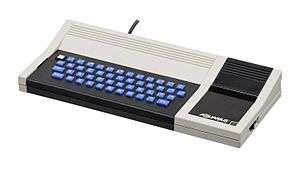 | |
| Type | Home computer |
|---|---|
| Release date | June 1983 |
| Introductory price | 160 US$ (today $410.72) |
| Discontinued | October 1983[1] |
| Media | Cassette tape, ROM Cartridge |
| Operating system | Microsoft BASIC |
| CPU | Zilog Z80A @ 3.5 MHz |
| Memory | 4KB RAM (expandable to 20KB), 8KB ROM |
| Input | Keyboard |
| Predecessor | Intellivision |
| Successor | Aquarius II |
History
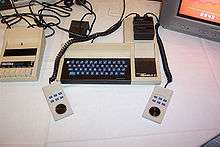
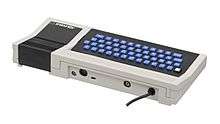
Looking to compete in the standalone computer market, Mattel Electronics turned to Radofin, the Hong Kong based manufacturer of their Intellivision consoles. Radofin had designed two computer systems. Internally they were known as "Checkers", and the more sophisticated "Chess". Mattel contracted for these to become the Aquarius and Aquarius II, respectively. Aquarius was announced in 1982 and finally released in June 1983, at a price of $160. Production ceased four months later because of poor sales. Mattel paid Radofin to take back the marketing rights, and four other companies—CEZAR Industries, CRIMAC Inc., New Era Incentives, Inc., and Bentley Industries—also marketed the unit and accessories for it. Bentley Industries (of Los Angeles) and New Era Incentives, Inc. (of St. Paul) are still in business, though they no longer have any affiliation with the Aquarius product line.
The Aquarius often came bundled with the Mini-Expander peripheral, which added game pads, an additional cartridge port for memory expansion, and the GI AY-3-8914 sound chip, which was the same one used on the Intellivision console. Other common peripherals were the Data recorder, 40 column thermal printer, 4K and 16K ram carts. Less common first party peripherals include a 300 baud cartridge modem, 32k RAM cart, 4 color plotter, and Quick Disk drive.
Although less expensive than the Texas Instruments TI-99/4A and Commodore VIC-20, the Aquarius had comparatively weak graphics and limited memory. Internally, Mattel programmers dubbed it "the system for the seventies".[2] Of the 32 software titles Mattel announced for the unit, only 21 were released, most of which were ports from Mattel's Intellivision game console. Because of the hardware limitations of the Aquarius, such as a lack of programmable graphics-- even though Mattel added a special Mattel Aquarius character set so games could at least use character graphics-- the quality of many games suffered. This is in contrast to other home video game companies of the era such as Atari and Coleco, which were branching out into the home computer market with computers that matched or exceeded the capabilities of their dedicated gaming consoles.
As a magazine of the time put it, "The Aquarius suffered one of the shortest lifespans of any computer—it was discontinued by Mattel almost as soon as it hit store shelves, a victim of the 1983 home computer price wars."[3] Just after the release of the Aquarius, Mattel announced plans for the release of the Aquarius II, and there is evidence that the Aquarius II reached the market in small numbers,[4][5] but was also not a commercial success.
Technical specifications
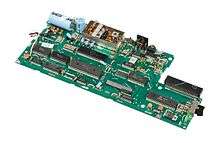
- CPU: Zilog Z80 @ 3.5 MHz
- Memory: 4K RAM, expandable to 20K RAM; 8K ROM
- Keyboard: 48-key rubber chiclet keyboard
- Display: 320 x 192 pixels (all available within borders), 40x24 text (8 x 8 pixel character block), 80x72 addressable graphics, 16 colors
- Sound: One voice, expandable to four voices
- Ports: Television, cartridge/expansion, tape recorder, printer
- PSU: Non-removable external power supply hard-wired into case providing 8.8 / 16 / 19 VDC
Hardware[6]
- Aquarius Mini Expander (Model #4063)- An expansion system that made game playing more exciting and easier. It came with 2 detachable 6-key 16-position disk hand controllers (similar to Intellivision controllers but with 6 keys instead of 12 and no side fire buttons). The unit added a decent sound chip (the same as used on the Intellivision) and gave the Aquarius 3 sound channels. It had two cartridge slots, allowing one to be used with a memory cartridge while the other could be used for a program cartridge.
- Aquarius Data Recorder (Model #4394)- A sequential file medium cassette player to store data and programs. It is 12" L x 8.5" W. It is sloped from the back (4" thickness) down to the front (2.5" thickness). It weighs 2.7 pounds and has its own internal power transformer & hardwired AC cord. The case and buttons are all white with a nice sculpted design. There is a black translucent panel over the cassette area; marking-wise, it has a black plate with "Aquarius Data Recorder" written on it, and a large colorful Aquarius logo. Once you get past the case, the unit is pretty much a standard 70's/80's portable cassette recorder. It has a resetable tape counter on the top, along with RECORD, PLAY, REWIND, FAST FWD., STOP/EJ. and PAUSE buttons. However, the recorder has no volume knob (though there is a small trimmer pot inside the unit); the volume is preset for the level the Aquarius likes. The unit also has no speaker. On the back of the unit are 3 jacks: EAR (EARphone, for audio output), MIC (MICrophone, for audio input) and REM (REMote control). The REM jack is unused by the Aquarius; the standard connecting cable, which was included with the recorder (and not sold separately) had only two plugs (marked MIC and EAR). There is a green "POWER" LED, which does not come on when the unit is plugged in, but instead lights when any movement button (like PLAY or REWIND) is pressed. The unit also has a red "DATA" LED which comes on when data is encountered on the playback/record circuit, whether or not the computer is processing such data. The "DATA" LED is fed via a bandpass filter, and will light up erratically if you put in a music cassette, etc. The Aquarius recording system uses a lightly tokenized save format for its BASIC recordings: all strings, program names, variables and values are stored as ASCII text, with only standard commands being tokenized. The Aquarius recording system operates at 600 baud, using 900 Hz and 1800 Hz tones. Input impedance is 82 ohms, output impedance is 2.4K ohms, and output level is 50mV.
- Data Recorder Tape (Model #4700)- Computer cassette tapes, marketed as having been designed specifically for the Aquarius Data Recorder.
- Aquarius Printer (Model #4210)- 40 column, narrow-paper thermal printer. 80 cps in upper/lower case text and 20 graphic lines per second. 5x7 character matrix at 10 cpi; thermal roll paper utilized up to 4-3/8" wide. Another incarnation of the narrow-width Alphacom 42 thermal printer that was OEMed for so many home computers of that era (e.g., as the Timex/Sinclair 2040, TI Solid State Printer, and Tandy TP-10).
- Aquarius 4-Color Printer (Model #4615)- A 4-color printer/plotter using small red, green, blue and black pens to draw graphics, or text 40 or 80 columns wide, on plain 4-1/2" roll paper. It was apparently an OEMed version of the small Alps printer/plotter that appeared under many manufacturers' names (e.g., the Commodore 1520, the Atari 1020, and the Tandy CGP-115).
- Printer Paper Pack (Model #4216)- Roll printer paper, marketed for use with either the Aquarius Printer or the Aquarius 4-Color Printer.
- Aquarius Modem (Model #4399)- A 300 baud modem with originate/answer capability and upload/download ability. The needed terminal software came on tape. It was intended to be used with "Aquarius Home Services", a Mattel on-line service tied in with CompuServe; and, the modem's official release was held pending start-up of that service. But, the latter never materialized, and the modem was never widely distributed.
- Aquarius Modem (Model #4820C)- The "C" in the model number indicates this was a CRIMAC-released item, in this case the CRIMAC model of the Aquarius modem. It too was 300 baud.
- Aquarius Master Expansion Module (Model #4398)- A large peripheral expansion box with room for two floppy disk drives and "seven built-in peripheral boards to expand Aquarius memory and expand it into the technology of the future at your own pace." It would have allowed not only use of the floppies for storage, but also utilization of the popular CP/M disk operating system and CP/M-compatible programs. Certainly not widely released.
- Aquarius Single Disk Drive (Model #4801C)- A stand-alone external double-sided disk drive for the Aquarius. This added not only 128K of disk capacity to the unit, being 64K on both sides of the special 2.8" disks, but also 128K of RAM.
- Quick Disks (Model #4825C)- These were the disks for the Single Disk Drive. 2.8", double sided, these were used to hold 128K (64K on each side).
- Com/Pac - This was simply a marketing package which included an Aquarius, Aquarius Printer, Aquarius Data Recorder, and Aquarius Mini Expander, all in one box.
Memory Cartridges:[6]
- 4K RAM Cartridge (Model #4214)
- 16K RAM Cartridge (Model #4215)
- 32K RAM Cartridge (Model #4217)
Practical/Educational Cartridges:[6]
- LOGO (#4890C)- Graphics programming with Turtle Graphics.
- FinForm (#4178)- 63 column by 255 row spreadsheet program.
- FileForm (#4177)- Database & word processing program.
- Extended Microsoft BASIC (#4392)- Programming with most if not all the remaining commands of full Microsoft BASIC. With this you were also able to access the Mini Expander's controllers to write games to use them.
- Hints From Heloise- Question and Answer program with helpful hints for common household questions ("Heloise" being the author of a popular newspaper column and an authority on housekeeping).
- Zero-In (#4895C)- Educational software.
- Biorhythms (#4673)- Software calculating the user's "biorhythm" cycles. Many home computers of the era had similar software exploring the "biorhythm" theory and whether the same had any predictive ability regarding daily performance.
- Space Speller (a/k/a Spelling in Space) (#4682)- Education in spelling.
- Melody Chase (#4920C)
Game Cartridges:[6]
- Advanced Dungeons & Dragons Treasures of Tarmin (#4023)
- Astrosmash (#4003)
- Burger Time (#4653)
- Bump and Jump (#4925C)
- Night Stalker (#4595)
- Reversi (#4594)
- Snafu (#4028)
- Tron Deadly Discs (#4024)
- Utopia (#4596)
- Chess (#4393)
- Lock 'N' Chase (#4029)
- Sea Battle
Tape recording format
The Aquarius uses a simple "FSK" (frequency shift keying) serial data system for saving and loading data from cassettes. Because such system uses sound data, the output can also be recorded on any other sound-sensitive media.
The Aquarius uses 900Hz and 1800Hz as its "Mark" and "Space" tones during recording. Each "Mark" represents a logical bit 1, and each "Space" represents a logical bit 0. When saving, data is just fed one bit at a time into a simple FSK circuit that translates the bits into corresponding sounds, and those sounds are saved on the cassette. Since "Spaces" and "Marks" have different play lengths, the data transfer rate is not constant; in well-mixed data the rate will be around 250-300 bits per second.
The Aquarius serial transmission format is 1 start bit, 8 data bits, and 2 stop bits. The Aquarius has no built in error checking in its tape save function, not even checksums or parity bits. This is why the Aquarius can report 'Ok' even when a CLOAD is incorrect.
Since each program can obviously control the data sent to the port, it is still possible for individual software programs to implement error checking in the system, or even redundant blocks. The FileForm text editor uses a simple checksum to determine if data transmission was OK, but cannot recover bad blocks since there are no redundant blocks saved in the data. (The FinForm spreadsheet use no error checking at all, and will happily load completely invalid data.)
Each type of Aquarius save has a specific format. For Aquarius BASIC:[6]
- 0 : 12 x $FF header (for the Aquarius to calibrate its bit length when loading)
- 12 : 1 x $00 space
- 13 : 6 x PROGRAM NAME IN ASCII
- 19 : 12 x $FF header
- 31 : 1 x $00 space
- 32 : .. x TOKENIZED AQUARIUS BASIC
- .. : 18 x $00 tail
For a FinForm data save:[6]
- 0 : 12 x $FF header (for the Aquarius to calibrate its bit length when loading)
- 12 : 1 x $00 space
- 14 : 6 x $CF (save name that cannot be typed in Aquarius BASIC)
- 20 : 7 x SAVE NAME IN ASCII
- 27 : 12 x $FF header
- 28 : 1 x $00 space
- 29 : .. x FINFORM INTERNAL DATA
- .. : 26 x $FF tail
For a FileForm data save:[6]
- 0 : 12 x $FF header (for the Aquarius to calibrate its bit length when loading)
- 12 : 1 x $00 space
- 14 : 6 x $8F (save name that cannot be typed in Aquarius BASIC)
- 20 : 7 x SAVE NAME IN ASCII
- 27 : 12 x $FF header
- 28 : 1 x $00 space
- 29 : .. x FILEFORM ASCII TEXT
- .. : 21 x $00 tail
Interfacing
The Aquarius manual did not contain details of any of the ports available. The cassette port although using the same 5-Pin DIN 41524 connector as the TRS-80, did not have the same pin out and thus was incompatible with readily available cables for the TRS-80, even though they physically fit the sockets on both the computer and cassette player. The Aquarius branded cassette deck came with the appropriate cable.[6]
The cassette port a 5-pin female DIN 41524 connector
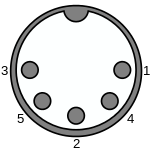
| Pin | Function Aquarius | Function TRS-80 |
|---|---|---|
| 1 | MIC | REMote |
| 2 | Common Ground | Common Ground |
| 3 | EAR | REMote |
| 4 | Not used | EAR |
| 5 | Not used | MIC |
The MIC and EAR connections from the Aquarius each go to the tip/center of one of the two mini-plugs being attached to the recorder; Ground goes to the base/outside of both mini-plugs.[6]
The printer interface is a mini-stereo socket with 3 lines, the same as on the Mattel Entertainment Computer System. The Aquarius printers came with their own cables. The interface conforms to RS-232 serial signal standards (+12VDC/-12VDC), with the knowledge of the pinout it is possible to interface printers with a corresponding RS-232 interface.[6] The serial is fixed to 1200 baud 8N2 and provided both carriage return and line feed commands to the printer, thus the printer needed to be set to not auto feed with carriage return.[6]
Pin out for the connector on the Aquarius:
| Aquarius | Function |
|---|---|
| Tip | Data Out (TxD) |
| Ring | Printer Busy/Ready (DSR) |
| Sleeve | Ground (GND) |
Typical serial printers had DB-25 interfaces; some had DE-9 interfaces; and, some Radio Shack (RS) printers had round 4-pin female DIN connector serial interfaces (with the pin sockets numbered left-to-right: 4, 3, 2, 1). The proper cable for connecting such a printer is as follows:[6]
MINI-STEREO PLUG DB-25 DE-9 RS FUNCTION
Tip/Center of Plug Pin 3 Pin 2 Pin 4 Data to Printer Middle of Plug Pin 20 Pin 4 Pin 2 Printer Busy/Ready Base/Outside Pin 7 Pin 5 Pin 3 Signal Ground
References
- Page 49, InfoWorld, 23 Jan 1984, ...John Allen, president of The Lisp Company...announcing TLC Logo, which could run on the Mattel Aquarius...Today, the Mattel Aquarius is virtually off the market...
- Klooster, Erik. "Mattel Aquarius - home computer with the shortest career". computermuseum.50megs.com. Retrieved 2020-01-28.
Besides that, the Mini Expander was equipped with the same sound chip (AY-3-8914) as the Intellivision. But that didn't appeal to the programmers: they almost considered it as a punishment to develop a game for the Aquarius. Programmer Bob Del Principe even invented this cynical slogan: 'Aquarius - system for the seventies!'
- "Mattel Aquarius Benchmark". COMPUTE! Magazine, April 1985, p18. Retrieved April 4, 2020.
- Mattel Aquarius II at old-computers.com Archived 2006-11-19 at the Wayback Machine, retrieved October 6, 2006
- Mattel Aquarius at perso.orange.fr (translated via Babel Fish, original article), retrieved October 6, 2006 Archived March 11, 2007, at the Wayback Machine
- Horvat/Parrish, “Mattel Aquarius FAQ,” May 6, 2001.
External links
| Wikimedia Commons has media related to Mattel Aquarius. |
- http://www.vdSteenoven.com/aquarius/
- http://oldcomputers.net/aquarius.html
- http://www.zophar.net/aquarius/
- The Dot Eaters entry on Aquarius and the Intellivision
- Sample videos of most Mattel Aquarius programs
- The Mattel Aquarius at The Centre for Computing History
- Mattel Aquarius Software Collection playable for free in the browser at the Internet Archive
